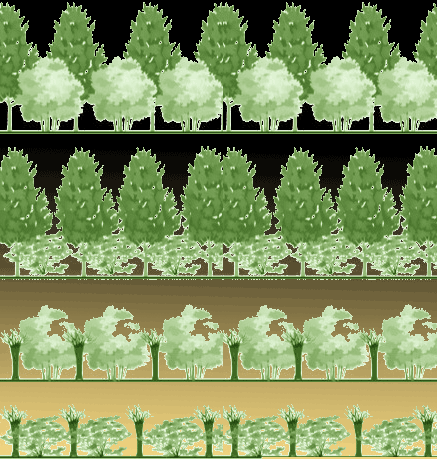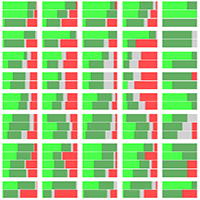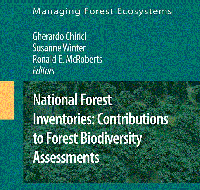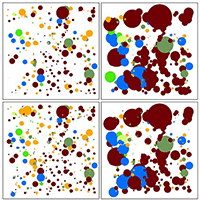The woody component along field edges often provides the only permanent elements of structural and biological diversity in landscapes that have lost much of their naturalness to agriculture and urban use. The main aims of this study were (i) to investigate how four hedge stand types, i.e., systems of management distinguished on the basis of the natural and managed growth forms of trees and shrubs (low single-storied, high single-storied, two-storied and multi-storied), differ in their biometric parameters and (ii) to identify the primary management-related determinants of native woody species richness. The study used a large dataset of hedgerows (n=538) sampled in seven sites in Northern Italy. The four hedge stand types exhibited highly significant differences in size and biometric parameters. The multi-storied hedges, associated with the highest stand structural diversity index values, supported the highest number of tree species, followed by high single-storied hedges. The low single-storied hedge stand type contained the lowest number of species. We found a positive effect of hedge area as well as a marginal negative effect of basal area on native woody species richness. The management implications addressed by our study include conversion of single-storied into two- or multi-storied types, increasing hedge size and controlling hedge stand basal area.
Keywords
, , , , , , ,
Citation
Sitzia T, Trentanovi G, Marini L, Cattaneo D, Semenzato P (2013). Assessment of hedge stand types as determinants of woody species richness in rural field margins. iForest 6: 201-208. - doi: 10.3832/ifor0749-006
Academic Editor
Paola Mairota
Paper history
Received: Aug 27, 2012
Accepted: Mar 05, 2013
First online: May 27, 2013
Publication Date: Aug 01, 2013
Publication Time: 2.77 months
© SISEF - The Italian Society of Silviculture and Forest Ecology 2013
Open Access
This article is distributed under the terms of the Creative Commons Attribution-Non Commercial 4.0 International (https://creativecommons.org/licenses/by-nc/4.0/), which permits unrestricted use, distribution, and reproduction in any medium, provided you give appropriate credit to the original author(s) and the source, provide a link to the Creative Commons license, and indicate if changes were made.

Breakdown by View Type
(Waiting for server response...)
Article Usage
Total Article Views: 59076
(from publication date up to now)
Breakdown by View Type
HTML Page Views: 48674
Abstract Page Views: 3350
PDF Downloads: 5274
Citation/Reference Downloads: 37
XML Downloads: 1741
Web Metrics
Days since publication: 4585
Overall contacts: 59076
Avg. contacts per week: 90.19
Article Citations
Article citations are based on data periodically collected from the Clarivate Web of Science web site
(last update: Mar 2025)
Total number of cites (since 2013): 15
Average cites per year: 1.15
Publication Metrics
by Dimensions ©
Articles citing this article
List of the papers citing this article based on CrossRef Cited-by.
(1)
Bannister NR, Watt TA (1995)Effects of cutting on the growth of
Crataegus monogyna (Hawthorn) in hedges. Journal of Environmental Management 45: 395-410.
CrossRef |
Gscholar
(2)
Bates FS, Harris S (2009)Does hedgerow management on organic farms benefit small mammal populations? Agriculture, Ecosystems & Environment 129: 124-130.
CrossRef |
Gscholar
(3)
Baudry J, Bunce RGH, Burel F (2000)Hedgerows: an international perspective on their origin, function and management. Journal of Environmental Management 60: 7-22.
CrossRef |
Gscholar
(4)
Bennett AF, Henein K, Merriam G (1994)Corridor use and the elements of corridor quality - chipmunks and fencerows in a farmland mosaic. Biological Conservation 68: 155-165.
CrossRef |
Gscholar
(5)
Benton TG, Vickery JA, Wilson JD (2003)Farmland biodiversity: is habitat heterogeneity the key? Trends in Ecology and Evolution 18: 182-188.
CrossRef |
Gscholar
(6)
Bickmore JC (2002)Hedgerow survey Handbook, a standard procedure for local surveys in the UK. Countryside Council for Wales, London, UK.
Gscholar
(7)
Bidese F, Peruffo A (1993)Rilievo del sistema di siepi ed alberate campestri in in’area agricola del Veneto. Acer 9 (6): 9-13. [in Italian]
Gscholar
(8)
Boutin C, Jobin B, Belanger L, Choiniere L (2002)Plant diversity in three types of hedgerows adjacent to cropfields. Biodiversity and Conservation 11: 1-25.
CrossRef |
Gscholar
(9)
Brokaw NVL, Lent RA (1999)Vertical structure. In: “Maintaining biodiversity in forest ecosystems” (Hunter ML ed). Cambridge University Press, Cambridge, UK, pp. 373-399.
Gscholar
(10)
Buongiorno J, Peyron JL, Houllier F, Bruciamacchie M (1995)Growth and management of mixed-species, uneven-aged forests in the French Jura. Implications for economic returns and tree diversity. Forest Science 41: 397-429.
Gscholar
(11)
Burel F (1996)Hedgerows and their role in agricultural landscapes. Critical Reviews in Plant Sciences 15: 169-190.
CrossRef |
Gscholar
(12)
Burel F, Baudry J (1995)Social, aesthetic and ecological aspects of hedgerows in rural landscapes as a framework for greenways. Landscape and Urban Planning 33: 327-340.
CrossRef |
Gscholar
(13)
Campagne P, Roche P, Tatoni T (2006)Factors explaining shrub species distribution in hedgerows of a mountain landscape. Agriculture Ecosystems & Environment 116: 244-250.
CrossRef |
Gscholar
(14)
Celesti-Grapow L, Pretto F, Carli E, Blasi C (2010)Flora vascolare alloctona e invasiva delle regioni d’Italia. Casa Editrice Università La Sapienza, Rome, Italy.[in Italian]
Gscholar
(15)
CIA (2003)Atlante dell’Agricoltura Veneta. Confederazione Italiana Agricoltori, Padua, Italy. [in Italian]
Gscholar
(16)
Deckers B, Hermy M, Muys B (2004a)Factors affecting plant species composition of hedgerows: relative importance and hierarchy. Acta Oecologica 26: 23-37.
CrossRef |
Gscholar
(17)
Deckers B, Verheyen K, Hermy M, Muys B (2004b)Differential environmental response of plant functional types in hedgerow habitats. Basic and Applied Ecology 5: 551-566.
CrossRef |
Gscholar
(18)
Forman RTT, Baudry J (1984)Hedgerows and hedgerow networks in landscape ecology. Environmental Management 8: 495-510.
CrossRef |
Gscholar
(19)
Franklin JF, Spies TA, Van Pelt R, Carey AB, Thornburgh DA, Berg DR, Lindenmayer DB, Harmon ME, Keeton WS, Shaw DC, Bible K, Chen J (2002)Disturbances and structural development of natural forest ecosystems with silvicultural implications, using Douglas-Fir forests as an example. Forest Ecology and Management 155: 399-423.
CrossRef |
Gscholar
(20)
Fritz R, Merriam G (1996)Fencerow and forest edge architecture in eastern Ontario farmland. Agriculture Ecosystems & Environment 59: 159-170.
CrossRef |
Gscholar
(21)
Green RE, Osborne PE, Sears EJ (1994)The distribution of passerine birds in hedgerows during the breeding-season in relation to characteristics of the hedgerow and adjacent farmland. Journal of Applied Ecology 31: 677-692.
CrossRef |
Gscholar
(22)
Hanewinkel M (1999)Successful examples of multiple forest use - the model of selection forests. In: Proceedings of the “Forests in focus: forum, biodiversity - treasures in the world’s forests” (Poker J, Stein I, Werder U eds). Alfred Toepfer Akademie für Naturschutz (Hamburg, Germany) 3-7 July 1998, pp. 90-93.
Gscholar
(23)
Herlin ILS, Fry GLA (2000)Dispersal of woody plants in forest edges and hedgerows in a southern Swedish agricultural area: the role of site and landscape structure. Landscape Ecology 15: 229-242.
CrossRef |
Gscholar
(24)
Hinsley SA, Bellamy PE (2000)The influence of hedge structure, management and landscape context on the value of hedgerows to birds: a review. Journal of Environmental Management 60: 33-49.
CrossRef |
Gscholar
(26)
Latham PA, Zuuring HR, Coble DW (1998)A method for quantifying vertical forest structure. Forest Ecology and Management 104: 157-170.
CrossRef |
Gscholar
(27)
Lexerød NL, Eid T (2006)An evaluation of different diameter diversity indices based on criteria related to forest management planning. Forest Ecology and Management 222: 17-28.
CrossRef |
Gscholar
(28)
Liang J, Buongiorno J, Monserud RA, Kruger EL, Zhou M (2007)Effects of diversity of tree species and size on forest basal area growth, recruitment, and mortality. Forest Ecology and Management 243: 116-127.
CrossRef |
Gscholar
(29)
MacDonald DW, Johnson PJ (1995)The relationship between bird distribution and the botanical and structural characteristics of hedges. Journal of Applied Ecology 32: 492-505.
CrossRef |
Gscholar
(30)
MacLean M (1992)New hedges for the countryside. Farming Press Books, Ipswich, UK.
Gscholar
(31)
Mannino I, Franco D, Zanetto G (2001)Reti ecologiche agroforestali e processi paesaggistici: la valutazione socio-economica. Genio Rurale 1: 22-28. [in Italian].
Gscholar
(32)
Maudsley MJ (2000)A review of the ecology and conservation of hedgerow invertebrates in Britain. Journal of Environmental Management 60: 65-76.
CrossRef |
Gscholar
(33)
McElhinny C, Gibbons P, Brack C, Bauhus J (2005)Forest and woodland stand structural complexity: its definition and measurement. Forest Ecology and Management 218: 1-24.
CrossRef |
Gscholar
(34)
Meeus JHA, Wijermans MP, Vroom MJ (1990)Agricultural landscapes in Europe and their transformation. Landscape and Urban Planning 18: 289-352.
CrossRef |
Gscholar
(35)
Metzger MJ, Bunce RGH, Jongman RHG, Mücher CA, Watkins JW (2005)A climatic stratification of the environment of Europe. Global Ecology and Biogeography 14: 549-563.
CrossRef |
Gscholar
(36)
Nordlind E, Ostlund L (2003)Retrospective comparative analysis as a tool for ecological restoration: a case study in a Swedish boreal forest. Forestry 76: 243-251.
CrossRef |
Gscholar
(37)
Osborne P (1984)Bird numbers and habitat characteristics in farmland hedgerows. Journal of Applied Ecology 21: 63-82.
CrossRef |
Gscholar
(38)
Padoa-Schioppa E, Baietto M, Massa R, Bottoni L (2006)Bird communities as bioindicators: the focal species concept in agricultural landscapes. Ecological Indicators 6: 83-93.
CrossRef |
Gscholar
(39)
Paoletti MG (1995)Biodiversity, traditional landscapes and agroecosystem management. Landscape and Urban Planning 31: 117-128.
CrossRef |
Gscholar
(40)
Parker GG, Brown MJ (2000)Forest canopy stratification - is it useful? American Naturalist 155: 473-484.
CrossRef |
Gscholar
(41)
Peterken G (1993)Woodland conservation and management. Second edition. Chapman & Hall, London, UK.
Gscholar
(42)
Pignatti S (1982)Flora d’Italia. Edagricole, Bologna, Italy. [in Italian]
Gscholar
(43)
Pinheiro J, Bates D, DebRoy S, Sarkar D, R Development Core Team (2011)Linear and nonlinear mixed effects models. R package version 3.1-101.
Gscholar
(44)
Pinheiro JC, Bates DM (2000)Mixed-effects models in S and S-PLUS. Springer Verlag, New York, USA.
CrossRef |
Gscholar
(45)
Pollard E, Hooper MD, Moore NW (1974)Hedges. W. Collins Sons, London, UK.
Gscholar
(46)
Pretzsch H (1997)Analysis and modelling of spatial stand structures. Methodological considerations based on mixed beech-larch stands in Lower Saxony. Forest Ecology and Management 97: 237-253.
CrossRef |
Gscholar
(47)
R Development Core Team (2011)R: a programming environment for data analysis and graphics. R Development Core Team, Wien, Austria.
Gscholar
(48)
Regione Veneto (2006)Rapporto statistico del Veneto. Regione Veneto, Direzione sistema statistico regionale, Venice, Italy. [in Italian]
Gscholar
(49)
Regione Veneto (2007)Piano Territoriale Regionale di Coordinamento. Ambiti di paesaggio. Atlante ricognitivo. Regione Veneto, Venice, Italy. [in Italian]
Gscholar
(50)
Reif A, Schmutz T (2001)Planting and maintaining hedges in Europe. IDF, Paris, France.
Gscholar
(51)
Risser G, Rice EL (1971)Diversity in tree species in Oklahoma upland forests. Ecology 52: 876-880.
CrossRef |
Gscholar
(52)
Roy V, de Blois S (2008)Evaluating hedgerow corridors for the conservation of native forest herb diversity. Biological Conservation 141: 298-307.
CrossRef |
Gscholar
(53)
Schulte BJ, Buongiorno J (1998)Effects of uneven-aged silviculture on the stand structure, species composition, and economic returns of loblolly pine stands. Forest Ecology and Management 111: 83-101.
CrossRef |
Gscholar
(54)
Sykes AK, Hannon SJ (2001)Fencerows as habitat for birds in an agricultural landscape in central Alberta, Canada. Ecoscience 8: 441-449.
CrossRef |
Gscholar
(55)
Sitzia T (2007)Hedgerows as corridors for woodland plants: a test on the Po Plain, northern Italy. Plant Ecology 188: 235-252.
CrossRef |
Gscholar
(56)
Sitzia T, Campagnaro T, McCollin D, Dainese M (2012)A miscellany of traditional management techniques of woody field margins on the Po Plain, Italy: implications for biodiversity conservation. In: “Hedgerow Futures” (Dover JW ed). Hedgelink, Stoke-on-Trent, UK, pp. 135-146.
Gscholar
(57)
Sutton RK (1992)Landscape ecology of hedgerows and fencerows in Panama Township, Lancaster County, Nebraska. Great Plains Research 2: 223-254.
Online |
Gscholar
(58)
Tempesta T (1989)Introduzione allo studio del paesaggio agrario del Veneto. Veneto Agricoltura 5 (suppl.): 1-31. [in Italian].
Gscholar
(59)
Tempesta T (2010)The perception of agrarian historical landscapes: a study of the Veneto plain in Italy. Landscape and Urban Planning 97: 258-272.
CrossRef |
Gscholar
(60)
Trisorio A (2005)Misurare la sostenibilità, indicatori per l’agricoltura italiana. Istituto Nazionale di Economia Agraria, Rome, Italy. [in Italian]
Gscholar
(61)
Vos W, Meekes H (1999)Trends in European cultural landscape development: perspectives for a sustainable future. Landscape and Urban Planning 46: 3-14.
CrossRef |
Gscholar
(62)
Wehling S, Diekmann M (2008)Factors influencing the spatial distribution of forest plant species in hedgerows of north-western Germany. Biodiversity and Conservation 17: 2799-2813.
CrossRef |
Gscholar
(63)
Willmot A (1980)The woody species of hedges with special reference to age in Church Broughton Parish, Derbyshire. Journal of Ecology 68: 269-285.
CrossRef |
Gscholar
(64)
Zanaboni A, Lorenzoni GG (1989)The importance of relict vegetation and hedges in the agroecosystems and environment reconstruction. Agriculture Ecosystems & Environment 27: 155-161.
CrossRef |
Gscholar


















